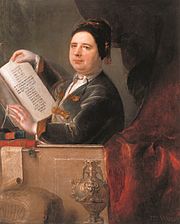Cruciform
Cruciform is a term for physical manifestations resembling a common cross or Christian cross. The label can be extended to architectural shapes, biology, art, and design.
Cruciform architectural plan

In the Western churches, a cruciform architecture usually, though not exclusively, means a church built with the layout developed in Gothic architecture. This layout comprises the following:
- An east end, containing an altar and often with an elaborate, decorated window, through which light will shine in the early part of the day.
- A west end, which sometimes contains a baptismal font, being a large decorated bowl, in which water can be firstly, blessed (dedicated to the use and purposes of God) and then used for baptism.
- North and south chapels, or in many cases other necessities such as an organ and toilets.
- The crossing, which in later designs often was under a tower or dome.
In churches that are not oriented with the altar at the geographical east end, it is usual to refer to the altar end as "liturgical east" and so forth.
Methodist tabernacles also have a cruciform shape.[1]
Another example of ancient cruciform architecture[2] can be found in Herod's temple, the second Jewish temple.
Cruciform DNA
DNA can undergo transitions to form a cruciform shape, including a structure called a Holliday junction. This structure is important for the critical biological processes of DNA recombination and repair mutations that occur in the cell.
Cruciform joint
A cruciform joint is a specific joint in which four spaces are created by the welding of three plates of metal at right angles.
Cruciform manuscript
A cruciform manuscript was a form of
Cruciform melody
In music, a melody of four pitches where a straight line drawn between the outer pair bisects a straight line drawn between the inner pair, thus forming a cross. In its simplest form, the cruciform melody is a changing tone, where the melody ascends or descends by step, skips below or above the first pitch, then returns to the first pitch by step. Often representative of the Christian cross, such melodies are cruciform in their retrogrades or inversions. Johann Sebastian Bach, whose last name may be represented in tones through a musical cryptogram known as the BACH motif that is a cruciform melody, employed the device extensively. The subject of the fugue in c-sharp minor from The Well-Tempered Clavier Book I is cruciform. See also: Cross motif.
Cruciform tail

Some airplanes use a cruciform tail design, wherein the horizontal
The cruciform tail gives the benefit of clearing the aerodynamics of the tail away from the wake of the engine, while not requiring the same amount of strengthening of the vertical tail section in comparison with a T-tail design.
Cruciform sword

The plain sword used by knights, distinctive due to the flat bar used as a guard. The overall shape of the sword when held point down is that of a cross.
It is believed this shape was encouraged by the church to remind Knights of their religion.[citation needed] It was however very popular due to the protection it offered to the hand and certain attacks that rely on the cross to trap the blade of the enemy. See Sword.
Cruciform web design
Cruciform web designs use a cross-shaped web page that expands to fill the width and height of the web browser window. There are a number of different approaches to implementing them.
Cruciform product design
In addition to common cross-shaped products, such as key chains and magnets, certain designers have gone so far as to create cruciform devices and accessories. For example, the mass-produced cruciform MP3 player "Saint B", or the "iBelieve", an accessory that converts the original iPod Shuffle into a cross shape designed by Scott Wilson in 2005. The cruciform MP3 players often come preloaded with audio files of the New Testament, but are mainly purchased for users to proudly display their faith.[3]
See also
References
- ISBN 9780801853258. Retrieved 1 July 2018.
- ISBN 0-19-288013-6.
- S2CID 143513427.

